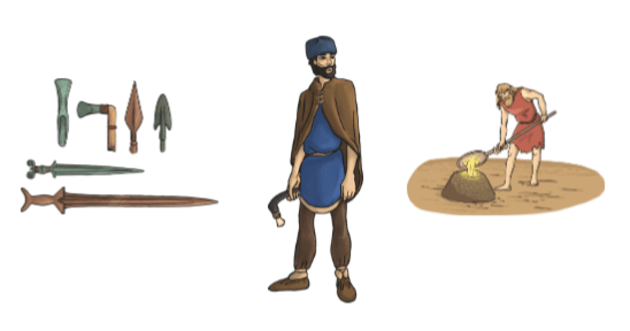

Prehistory is any time that occurred before Human societies developed writing systems. Because different cultures across the world developed writing at different times, prehistory ends at different points in history depending on location.
Prehistory is made up of every point in time since the beginning of the universe, though for world history it is usually used to refer to the span of time between the evolution of the first Humans to the development of writing. In Egypt, prehistory is thought to have ended around 3200 BC.
Historians use a three-age system to divide up the ages of Human progress in Eurasia. These are:

The Stone Age lasted for 3.4 million years and ended between 8,700 BC and 2,000 BC. During this age, Humans used stone tools such as axes. The Stone Age is divided into three periods:
The Stone Age ended with the discovery of metalworking, which led to the Bronze Age.

The Bronze Age started at around 3300 BC and ended between 1200 BC and 600 BC. During this age, Humans discovered how to work metals with low melting points such as copper and tin, and this led to the discovery of bronze.
Although Humans were still unable to use iron due to its high melting point, working with bronze allowed them to refine their techniques and create more effective tools and weapons. This led to further improvements in hunting techniques and agriculture.
Human society further evolved with the rise of trade. Early trading systems involved Human settlements exchanging excess food or resources for things they needed, in a system called bartering. Trade routes appeared both on land and across seas.

The Iron Age started in about 1200 BC and has different end points for different countries across the world, with some moving out of the Iron Age as early as 700 BC.
When Humans discovered how to use iron to make tools, bronze was soon replaced as iron was cheaper and more plentiful, meaning many more people had access to the tools they needed.
Iron is a much stronger metal than bronze and the ability to make tools and weapons from iron led to a period of significant technological progress for humanity.
During the Iron Age Humans began to build forts, establish large religions, wage wars and develop their society with advancements in language and medicine.
Due to the fact that there are no records of history during the prehistoric period, there is much debate over when exactly the period of prehistory ends. This is made more complicated by the fact that different cultures in different parts of the world progressed through the three ages at different times, and at different speeds.
If you need a resource for your lesson plan focusing on prehistory, you might want to download this free Prehistoric Britain History Fact Sheet, which is great for providing basic information for planning a lesson around, or just as a fun learning resource for adults or older children.
If you are teaching prehistory to young children then there are several resources which are great for use in your lesson plan. These include this Introduction to the Stone Age PowerPoint, Introduction to the Bronze Age PowerPoint, and Introduction to the Iron Age PowerPoint, which provides an educational and exciting learning experience for children of all ages.
 Home
Home  Membership
Membership  Customer Support
Customer Support  Create
Create  Blog
Blog 




















